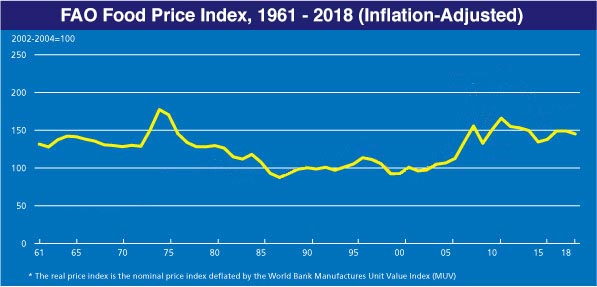| Above: A farm worker and the son of a friend check the carcass of a cow which died during a severe drought in Benito Juarez, Argentina, on January 26, 2009. The 2018 drought in Argentina threatens to bring the nation its worst harvest since the 2009 drought year. Image credit: JUAN MABROMATA/AFP/Getty Images. |
A severe lack of rainfall over southern South America during the summer of 2017 - 2018 has led to the worst drought in decades over portions of Argentina and Uruguay. According to insurance broker Aon Benfield, total losses are near $3.9 billion, making the drought the most expensive weather-related disaster on the planet so far in 2018--and the most expensive disaster in the history of both Argentina and Uruguay.
Hardest-hit was Argentina, where the Buenos Aires Grain Exchange predicted that the drought would likely cause an economic loss of $3.4 billion. Argentina’s 2018 soybean harvest is expected to be near the record-low harvest of the drought year of 2009; both severe droughts occurred during weak La Niña events. According to EM-DAT, the international disaster database, the $3.4 billion cost of this year’s drought exceeds a $3 billion flood (2018 dollars) from October 1985 as Argentina’s most expensive disaster on record.
The lack of summer rainfall this year in Uruguay has led to the worst drought conditions in that nation since 2008/09. Local industry officials anticipated economic losses exceeding $500 million, which would rank as that nation’s most expensive disaster in history. The previous record was the $380 million cost of a drought in 1999.
 |
| Figure 1. Drought conditions over South America on March 26, 2018, as measured using the 3-month Standardized Precipitation Index (SPI). Image credit: Latin American Flood and Drought Monitor, Princeton.edu. |
Global food supply still in good shape
It’s always a concern for global food prices when a top grain exporter suffers a serious drought. Argentina is the world’s No. 2 exporter of corn, behind the U.S., and is also the world’s third largest producer and exporter of soybeans, behind the U.S. and Brazil. In addition, Argentina is the world’s top supplier of soybean meal (used to feed livestock), accounting for 48 percent of total global shipments of soybean meal in 2017. Corn prices in the U.S. have risen 14% since December and soybean prices have risen 8% due to the Argentina drought, as global supplies have tightened and demand has risen. In addition, the global price of food as measured by the U.N.'s FAO Food Price Index increased by about 1% from January to February 2018, due to the Argentina drought. According to Reuters, though, the drought “has not ended a scenario of global oversupply left by years of bumper harvests driven by good weather and genetically engineered crops.” They noted that global soybean inventories are still at a record high, up 87 percent from 10 years ago, according to the U.S. Agriculture Department.
 |
| Figure 2. The global price of food between 1961 – January 2018, as measured by the U.N.'s FAO Food Price Index. The FAO Food Price Index is a measure of the monthly change in international prices of a basket of food commodities. It consists of the average of price indices for cereals, oils and fats, sugar, dairy, and meat, weighted by the average export shares of each group. Food prices between 2002 - 2004 are given a benchmark value of "100". Droughts in Russia in 1972 and again in 2010 caused the two largest spikes in the index since 1961. Food prices have been stable the past few years due to good harvests. The index increased by about 1% from February 2018 compared to January 2018, due the drought in South America (not shown). Image credit: Food and Agriculture Organization of the United Nations. |
My 2016 post, Food System Shock: Climate Change's Greatest Threat to Civilization, argued that the greatest threat of climate change to civilization over the next 40 years is likely to be climate change-amplified extreme droughts and floods hitting multiple major global grain-producing "breadbaskets" simultaneously. I predicted that an extreme weather year capable of causing a significant disruption of the global economy, intense political turmoil, war and the threat of mass famine was increasing in probability, becoming a 1-in-50-year event 40 years from now--a 2% chance of happening in a given year--due to the increasingly extreme nature of the jet stream, when combined with the ongoing increase in global temperatures, drought intensity, and heavy precipitation events. With one major grain producing area already suffering a significant loss in crop yield so far in 2018, we ordinarily would need to be concerned about the possibility of an extreme drought in the U.S. or Europe this summer causing a major “food shock” event. However, consecutive years of good harvests leading up to 2018 have left us in good shape to withstand any potential further hits to the global food supply that might occur this year.
Have an excellent Easter weekend, everyone!



